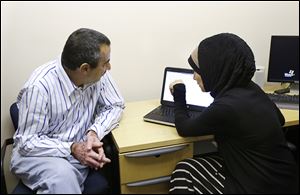
OBAMACARE
Glitches reported in health-care rollout
Insurance Web sites see heavy volume
10/2/2013
ACCESS Community Health and Research Center Navigator Nancy Berry, right, looks over an Affordable Care Act cost calculator with Hussein Daoud at the agency's center in Dearborn, Mich.
WASHINGTON — Heavy volume contributed to technical problems and delays that plagued the rollout Tuesday of the online insurance markets at the heart of President Obama’s health-care law, according to state and federal officials, who were watching closely for clues to how well the system will work and how many people will take advantage of it.
Many people who tried to compare plans and shop for coverage at healthcare.gov, the federally run exchange that serves as the marketplace for residents of most states, met with messages citing high traffic and advising, “Please wait here until we send you to the login page,” or “The system is down at the moment.”
Mr. Obama said that more than 1 million people had visited the federal site by 7 a.m., more than five times as much traffic as experienced by Medicare’s Web site. He said his administration would fix technical problems and adjust to “this demand that exceeds anything that we had expected.”
States that operate their own enrollment sites reported widely varying levels of traffic, but most said the systems were working, though with some problems caused by having more people than expected go to the exchanges.
In the first few hours that their exchanges were operating, New York state’s reported 2 million visits, Kentucky’s 24,000, Illinois’ more than 62,000, and Connecticut’s 14,000. Most of those people were browsing and comparing options; the numbers attempting to enroll in an insurance plan were far smaller, and there were more problems reported with that process.
The administration has stressed that consumers could also phone call centers or go in person to social service agencies, which can be found at localhelp.healthcare.gov, that have been designated as “navigators” to help people through the process. But those systems also stumbled out of the gate, dependent on the same computer systems used by people who went online.
At the Spectrum Health Center in Philadelphia, only a handful of people looking for services arrived Tuesday morning, outnumbered by the people there to help them weigh options and choose one. A consumer, Daniel Flynn, worked with a counselor, Kyle Rouse, but they found that while they could compare plans, they could not get into the system to apply for one.
Mr. Flynn, 28, who has private coverage, said he learned that through the exchange, “I would potentially pay the same for a plan that’s significantly better,” with fewer out-of-pocket costs.
Another consumer, Roderick Schichtel, who is uninsured, learned that he does not earn enough money to qualify to buy insurance through an exchange, but would qualify for the Medicaid coverage, which was expanded under the health law.
At the Jessie Trice Community Health Center, in a poor section of Miami, out of about 70 people who arrived seeking help with the new program before noon, no one was able to get access to the marketplace. All were given appointments to come back another week.
In Ohio, there were no “navigators” ready to help people on the first day of enrollment, because the state Department of Insurance has not yet authorized any of them.
And in Kentucky, by 9 a.m. the state-run insurance exchange was freezing up, with users unable to take even the first step of creating an account. Spokesman Gwenda Bond said more than 1,000 applications had been processed online by 9:30 a.m., and that the “high volume of traffic” was to blame for the technical problems.
“This surge of early applications demonstrates the pent-up demand for quality health coverage,” Ms. Bond said.
It was unclear to what degree problems with the federal Web sites were a result of the kind of technical hurdles that supporters of the program had warned about and that opponents had predicted would demonstrate its unwieldiness.
Some cybersecurity efforts raised the possibility that the system had been hit by a “denial of service” attack, in which people use linked networks of computers to cause a system to crash by flooding it with traffic.
Tuesday also brought a partial shutdown of the federal government, after the Republican majority in the House said it would pass a bill financing continued operation of the government only if that bill also eliminated money for the Affordable Care Act or delayed its being put into effect for a year.
Insurance bought through the exchanges by Dec. 15 would take effect Jan. 1. The open enrollment period runs through March. The 2010 health-care law calls for most Americans to have insurance. Those who go without coverage may be subject to tax penalties.